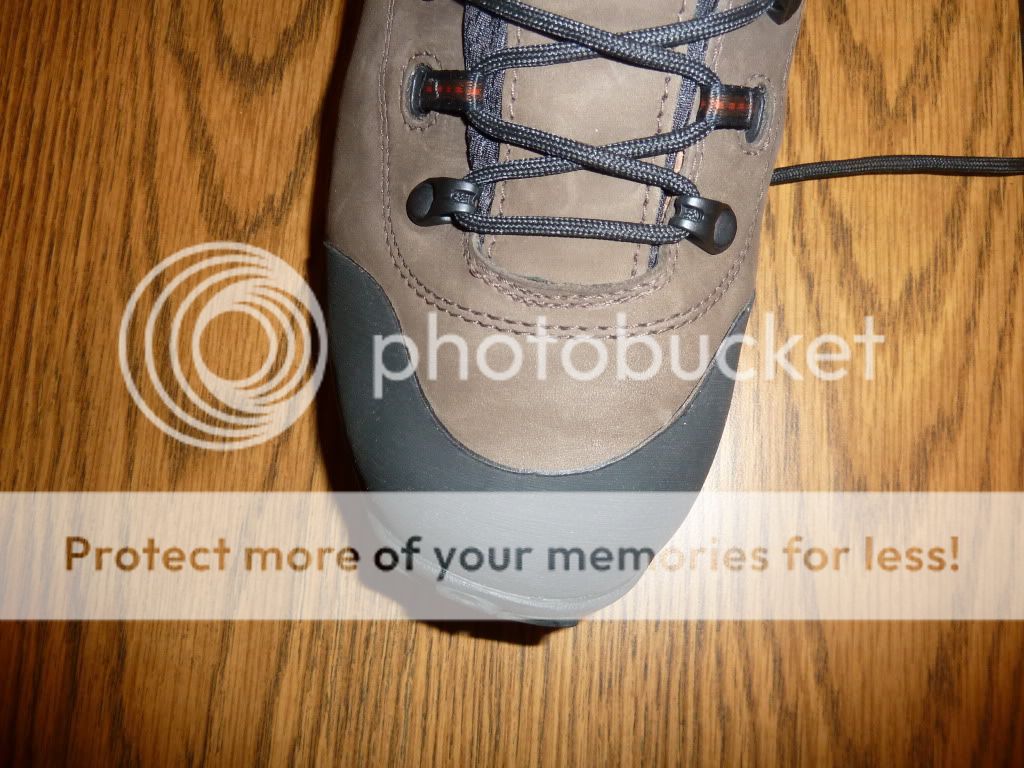Here are some of the things that I look for in a good pair of hiking boots. I'm not going to cover differnet height uppers because that is a matter of personal preference and usage.

1. The toe. Having a toe that is reinforced with rubber extends the life of your boot.
2. The lacing pattern. The farther the laces go down to the toe of the boot the more you can adjust the fit of the boot as your foot swells from walking mile after mile or from standing for long periods of time. (Like at work)
3. The gusset. The gusset keeps foreign objects (sand, rocks, dirt, snow, etc.) from entering the boot. The higher up the gusset goes the less stuff can get in your boots but your feet will sweat more.
4. The In-step. This feature keeps your foot from sliding forward toward the toe of your boot while walking down an incline. The farther down the in-step is placed the more adjustable it will be.
5. The Balance. This is padding usually made of foam and reinforced with a thin strip of aluminum or steel. It supports the arch and makes the boot more comfortable for extended wear. A lot of inexpensive boots don’t have this. A cheap foam insert on the inside of the boot is NOT a balance. A good test is to try to bend the toe of the boot backwards to the heel. If there is too much bend or if it bends too easily; that’s a bad thing. Here is an example of a poor balance.

6. The tread. The tread should be traction able and have a pattern that helps traction.
7. The upper. The more layers of material and seams the more ways water can get in. Lots of seams also means a greater possibility stitches popping on the boot. Only get Gortex if you know that you will be submerging the boot in water. Otherwise your feet are sweating more without any benefit.
These next three pictures are of a friend’s pair boots. They are about a year old.

These boots have a reinforced toe but the laces don’t go down as far.

This pair of boots has full gusset. There are many layers of material and one of the seams has popped.

The tread pattern on this pair of boots is kind of random and can be slippery on some surfaces.
These are a pair of boots I recently bought.

The toe is reinforced and lacing comes down a little farther.

This boot has a full gusset. There are also fewer layers and seams.

The tread pattern is uniform and wider spaced grooves throughout the tread pattern.

1. The toe. Having a toe that is reinforced with rubber extends the life of your boot.
2. The lacing pattern. The farther the laces go down to the toe of the boot the more you can adjust the fit of the boot as your foot swells from walking mile after mile or from standing for long periods of time. (Like at work)
3. The gusset. The gusset keeps foreign objects (sand, rocks, dirt, snow, etc.) from entering the boot. The higher up the gusset goes the less stuff can get in your boots but your feet will sweat more.
4. The In-step. This feature keeps your foot from sliding forward toward the toe of your boot while walking down an incline. The farther down the in-step is placed the more adjustable it will be.
5. The Balance. This is padding usually made of foam and reinforced with a thin strip of aluminum or steel. It supports the arch and makes the boot more comfortable for extended wear. A lot of inexpensive boots don’t have this. A cheap foam insert on the inside of the boot is NOT a balance. A good test is to try to bend the toe of the boot backwards to the heel. If there is too much bend or if it bends too easily; that’s a bad thing. Here is an example of a poor balance.

6. The tread. The tread should be traction able and have a pattern that helps traction.
7. The upper. The more layers of material and seams the more ways water can get in. Lots of seams also means a greater possibility stitches popping on the boot. Only get Gortex if you know that you will be submerging the boot in water. Otherwise your feet are sweating more without any benefit.
These next three pictures are of a friend’s pair boots. They are about a year old.

These boots have a reinforced toe but the laces don’t go down as far.

This pair of boots has full gusset. There are many layers of material and one of the seams has popped.

The tread pattern on this pair of boots is kind of random and can be slippery on some surfaces.
These are a pair of boots I recently bought.

The toe is reinforced and lacing comes down a little farther.

This boot has a full gusset. There are also fewer layers and seams.

The tread pattern is uniform and wider spaced grooves throughout the tread pattern.
Last edited:
